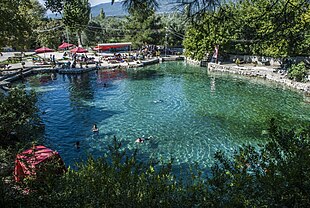


Renewables supply a quarter of energy in Turkey, including heat and electricity. Some houses have rooftop solar water heating, and hot water from underground warms many spas and greenhouses. In parts of the west hot rocks are shallow enough to generate electricity as well as heat. Wind turbines, also mainly near western cities and industry, generate a tenth of Turkey’s electricity. Hydropower, mostly from dams in the east, is the only modern renewable energy which is fully exploited. Hydropower averages about a fifth of the country's electricity, but much less in drought years.[3] Apart from wind and hydro, other renewables; such as geothermal, solar and biogas; together generated almost a tenth of Turkey’s electricity in 2022.[4] Over half the installed capacity for electricity generation is renewables.[5]: section 4.2.1
Turkey has a long history of wood burning, windmills, and bathing in hot springs. Many dams were built from the mid-20th to early 21st century, but some say that governments have not allowed civil society enough influence on energy policy, leading to protests against building dams, geothermal power plants, and at least one wind farm.[6] Despite Turkey’s sunny climate solar power is underdeveloped. As the electricity system is already flexible increasing to 70% renewables is easily feasible.[7]: 21 Solar power could be expanded more quickly if the electricity grid was improved faster and energy policy revised, especially by abolishing fossil fuel subsidies.
Many hybrid power plants are planned, and batteries are being integrated. Companies with a lot of renewables include the state electricity generation company (mainly hydro), Aydem, and Kalyon. If renewables could help phase-out coal by 2030, instead of by the national net zero greenhouse gas emissions target year of 2053, that would have significant health benefits and reduce inflation in Turkey.[8] As of 2022 renewables are not sufficient to meet that target year.[9] Various electric vehicles are being manufactured, which will use some of the increased renewable generation and help reduce air pollution.
- ^ "Keramet Thermal Spring". Bursa Turizm Portalı. Archived from the original on 15 July 2022. Retrieved 15 July 2022.
- ^ "Denge Tabloları" [Balance Tables]. Ministry of Energy and Natural Resources. Retrieved 25 September 2022.
- ^ Lessons from global experiences for accelerating energy transition in Turkey through solar and wind power (PDF) (Report). Shura. 2019. Retrieved 19 February 2019.
- ^ "Executive Summary: Net Zero 2053: A Roadmap for the Turkish Electricity Sector" (PDF). Shura. 2023.
the share of the renewables is almost 40%
- ^ First Biennial Transparency Report of Türkiye (PDF) (Report). Ministry of Environment, Urbanisation and Climate Change. November 2024.
- ^ Tezcür, Günes Murat (2022). The Oxford Handbook of Turkish Politics. Oxford University Press. ISBN 978-0-19-006489-1.
- ^ Cite error: The named reference
:5was invoked but never defined (see the help page). - ^ Hanson, Matt A. (2024-06-27). "Turkey's Potential to Lead EU Decarbonization". Non Profit News | Nonprofit Quarterly. Retrieved 2024-11-11.
- ^ Ergenç, Ceren; Göçer, Derya (5 May 2023). "China's Response to Türkiye's Volatile Authoritarianism". Carnegie Endowment for International Peace.
